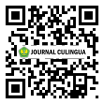METAPHOR ON JAPANESE SONG LYRIC BY MIWA: A STYLISTIC STUDY
DOI:
https://doi.org/10.37301/culingua.v2i1.21Keywords:
Figurative language, metaphor, stylisticAbstract
The uniqueness of literary language is full of ambiguity, having no rule, sometimes irrational, and connotative. Figurative language is not only referential that refers to certain thing but it has also expressive function that shows the author behavior. Various kinds of technique had been created by the author; he used figurative languages, imageries, and certain diction to attract the readers. Stylistic is a science that study the use of language and language style in literary work including sound, diction, sentence, discourse, figurative language, and imageries. This research aims to unveil figurative languages used in Japanese song lyric written by Miwa entitled, Kimi ni Deaeta Kara, and to observe the objective of using connotative language as expression of the author to express his ideas. This research used was stylistic theory to analyze figure of speech and its meaning. The result found that the use of metaphor to express something as the same thing or equal too another thing that is actually not the same. Metaphor gives freshness in language, animates the lifeless, keeps away the boredom because of monotone, and actualizes something. Based on the result of the analysis, the song written has a theme of love; a lot of dictions symbolize love. Figure of speech used by the author adds aesthetic value of the song lyric and the message of the author is well delivered.
References
Banjaransari, A. (2017). Makna Lirik Lagu Band Happy Endo. Nasional University.
Cresswel, J. W. (2013). Research Design. Pendekatan Kualitatif Kuantitatif, dan Mixed.
Darwis, M. (2009). Kelainan ketatabahasaan dalam puisi indonesia: kajian stilistika. 1–10. Retrieved from https://search120.com/search?q=Kelainan+Ketatabahasaan+Dalam+Puisi+Indonesia%3A+Kajian+Stilistika.
Dita, S. N. (2010). A stylistic analysis of Montage. 3L The Southeast Asian Journal of English Language Studies, 16(2), 169. https://doi.org/10.1017/CBO9781107415324.004
Imrom A.M., A. (2009a). Kajian Stilistika Novel Ronggeng Dukuh Paruk Karya Ahmad Tohari dan Pemaknaannya. Kajian Linguistik Dan Sastra, 21(1), 67–80. Retrieved from http://journals.ums.ac.id/index.php/KLS/article/view/4393/2818
Imrom A.M., A. (2009b). Stilistika: Teori, Metode, dan Aplikasi Pengkajian Estetika Bahasa. Surakarta: Cakra Books Solo.
Kenichi, S. (2002). Nihongo no Retorikku. Japan: Paperback Shinsho.
Keraf, G. (2010). Diksi dan Gaya Bahasa. Jakarta: PT Gramedia.
Lakoff, G., & Johnson, M. (1980). Metaphors We Live By. Chicago: The University of Chicago Press.
Lodge, D. (1967). Language of Fiction. London: Chatto and Windus.
Permatasari, D. (2017). Penggunaan Majas Dalam Lirik Lagu Karya Ikimono Gakari?: Tinjauan Stilistika Penggunaan Majas Dalam Lirik Lagu. Retrieved from http://eprints.undip.ac.id/58649/1/SKRIPSI_FULL.pdf_FULL.pdf.pdf
Pradopo, R. D. (2012). Pengkajian Puisi. Yogyakarta: Gadjah Mada University Press.
Pranata, D. (2017). Imaji, majas dan diksi dalam tiga lagu jepang yang berjudul sakura sebuah kajian stilistika. Retrieved from http://eprints.undip.ac.id/56689/1/SKRIPSI_FULL.pdf.pdf
Ratna, N. K. (2017). Stilistika. Kajian Puitika Bahasa, Sastra, dan Budaya. Yogyakarta: Pustaka Pelajar.
Subroto, D. E. (1996). Semantik Leksikal I dan II. Surakarta: Sebelas Maret University Press.
Downloads
Published
Issue
Section
License
Copyright (c) 2021 Fairuz Jama'an

This work is licensed under a Creative Commons Attribution 4.0 International License.









